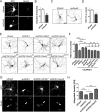Adaptor Complex 2 Controls Dendrite Morphology via mTOR-Dependent Expression of GluA2
- PMID: 28190237
- PMCID: PMC5820378
- DOI: 10.1007/s12035-017-0436-3
Adaptor Complex 2 Controls Dendrite Morphology via mTOR-Dependent Expression of GluA2
Abstract
The formation of dendritic arbors in neurons is a highly regulated process. Among the regulators of dendritogenesis are numerous membrane proteins that are eventually internalized via clathrin-mediated endocytosis. AP2 is an adaptor complex that is responsible for recruiting endocytic machinery to internalized cargo. Its direct involvement in dendritogenesis in mammalian neurons has not yet been tested. We found that the knockdown of AP2b1 (β2-adaptin), an AP2 subunit, reduced the number of dendrites in developing rat hippocampal neurons and decreased α-amino-3-hydroxy-5-methyl-4-isoxazolepropionic acid (AMPA) receptor subunit GluA2 levels by inhibiting mechanistic/mammalian target of rapamycin (mTOR). The dendritic tree abruption that was caused by AP2b1 knockdown was rescued by the overexpression of GluA2 or restoration of the activity of the mTOR effector p70S6 kinase (S6K1). Altogether, this work provides evidence that the AP2 adaptor complex is needed for the dendritogenesis of mammalian neurons and reveals that mTOR-dependent GluA2 biosynthesis contributes to this process.
Keywords: AP2b1; Dendritic arbor; GluA2; mTOR.
Conflict of interest statement
None of the authors have any financial or non-financial competing interests in the manuscript.
Figures







References
-
- Stuart G, Spruston N, Häusser M. Dendrites. 2. Oxford: Oxford University Press; 2007.
-
- Urbanska M, Blazejczyk M, Jaworski J. Molecular basis of dendritic arborization. Acta Neurobiol Exp Wars. 2008;68:264–288. - PubMed
Publication types
MeSH terms
Substances
Grants and funding
LinkOut - more resources
Full Text Sources
Other Literature Sources
Research Materials
Miscellaneous

